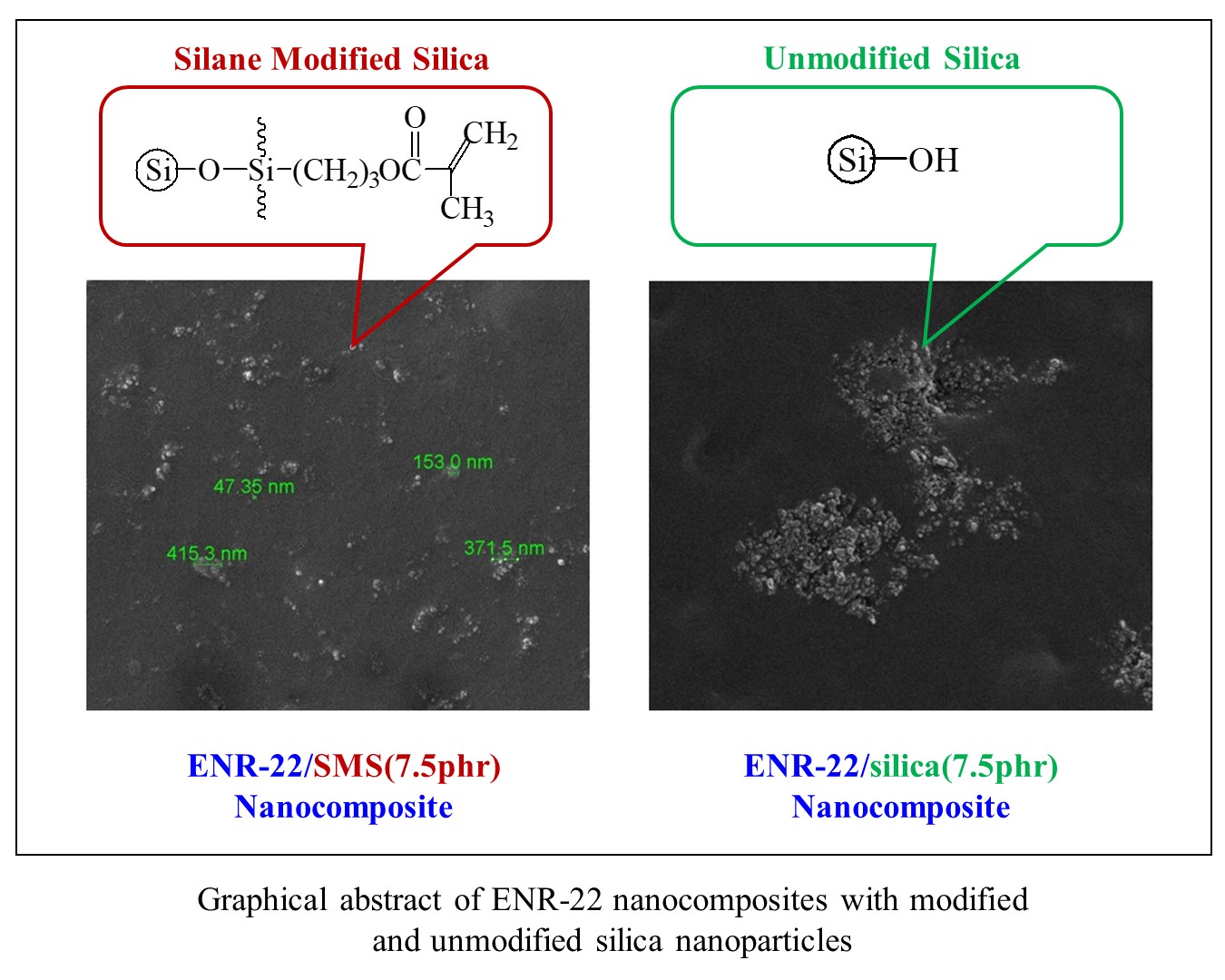Epoxidized natural rubber/silane modified silica nanocomposites prepared in latex stage
DOI:
https://doi.org/10.55713/jmmm.v32i1.1242คำสำคัญ:
epoxidized natural rubber, modified silica, nanocomposite, oil resistanceบทคัดย่อ
Epoxidized natural rubber (ENR) was synthesized from natural rubber (NR) latex via in situ epoxidation using HCOOH and H2O2. The prepared ENR with 22 mol% epoxidation (ENR-22) was reinforced with silane modified silica (SMS) nanoparticles with different SMS loading in latex stage. The tensile properties, thermal stability, oil resistance and morphology of the ENR-22/SMS nanocomposites were investigated. The tensile strength was improved significantly and gained the maximum point at 7.5 phr SMS content. The thermogravimetric analysis showed an increased initial degradation temperature with the addition of SMS, suggesting higher thermal stability of the nanocomposites. The oil resistance of ENR-22/SMS nanocomposites in IRM 901 oil and IRM 903 oil were increased with the increasing amount of SMS content, indicating having improved oil resistance. The morphology revealed that the dispersions of SMS have been significantly improved since most of the spherical clusters of nanoparticles were individually scattered among the ENR matrix.
Downloads
เอกสารอ้างอิง
Y. Wei, H. Zhang, L. Wu, L. Jin, and S. Liao, “A review on characterization of molecular structure of natural rubber,” MOJ Polymer Science, vol. 1, pp. 197-199, 2017.
Y. Tanaka, “Structure and biosynthesis mechanism of natural polyisoprene,” Progress in Polymer Science, vol. 14, pp. 339-371, 1989.
S. Riyajan, K. Tanbumrung, and P. Pinyocheep, “Physical properties of a green polymer blend based on PVA starch and ENR,” KGK Kautschuk Gummi Kunststoffe, vol. 63, pp. 371-376, 2010.
V. Tanrattanakul, B. Wattanathai, A. Tiangjunya, and P. Muhamud, “In situ epoxidized natural rubber: improved oil resistance of natural rubber,” Journal of Applied Polymer Science, vol. 90, pp. 261-269, 2003.
S. Chuayjuljit, C. Yaowsang, N. Na-Ranong, and P. Potiyaraj, “Oil resistance and physical properties of in situ epoxidized natural rubber from high ammonia concentrated latex,” Journal of Applied Polymer Science, vol. 100, pp. 3948-3955, 2006.
C. Ruksakulpiwat, S. Nuasaen, C. Poonsawat, and P. Khansawai, “Synthesis and modification of epoxidized natural rubber from natural rubber latex,” Advanced Materials Research, vol. 47-50, pp. 734-737, 2008.
R. Yoksan, “Epoxidized natural rubber for adhesive applications,” Kasetsart Journal (Natural Science), vol. 42, pp. 325-332, 2008.
S. Chuayjuljit, T. Nutchapong, O. Saravari, and A. Boonmahitthisud, “Preparation and characterization of epoxidized natural rubber and epoxidized natural rubber/carboxylated styrene butadiene rubber blends,” Journal of Metals, Materials and Minerals, vol. 25, pp. 27-36, 2015.
S. Riyajan and W. Sukhlaaied, “Effect of chitosan on gel content of epoxidized natural rubber grafted with chitosan in latex form,” Materials Science and Engineering C, vol. 33, pp. 1041-1047, 2013.
N. V. Bac, L. Terlemezyan, and M. Mihilov, “Epoxidation of natural rubber in latex in the presence of a reducing agent,” Journal of Applied Polymer Science, vol. 50, pp. 845-849, 1993.
A. K. Manna, D. K. Tripathy, P. P. De, S. K. De, M. K. Chatterjee, and D. G. Peiffer, “Bonding between epoxidized natural rubber and clay in presence of silane coupling agent,” Journal of Applied Polymer Science, vol. 72, pp. 1895-1903, 1999.
R. M. B. Fernandes, L. L. Y. Visconte, and R. C. R. Nunes, “Curing characteristics and aging properties of natural rubber/ epoxidized natural rubber and cellulose II,” International Journal of Polymeric Materials, vol. 60, pp. 351-364, 2011.
H. Ismail, A. Rusli, and A. A. Rashid, “The effect of filler loading and epoxidation on paper-sludge-filled natural rubber composites,” Polymer-Plastic Technology and Engineering, vol.45, pp. 519-525, 2006.
J. Johns, and C. Nakason, “Dielectric properties of natural rubber/ chitosan blends: effects of blend ratio and compatibilization,” Journal of Non-Crystalline Solids, vol. 357, pp.1816-821, 2011.
A. A. Aziz, N. S. Abdullah, M. S. J. Singh, and M. M. Kamal, “Effect of concentrated ENR on ENR/Si masterbatch,” Advanced Materials Research, vol. 832, pp. 832-837, 2014.
S. M. Li, T. W. Xu, B. C. Zhong, Y. F. Luo, D. M. Jia, and Z. Peng, “Preparation and stress-strain behavior of in-situ epoxidized natural rubber/SiO2 hybrid through a sol-gel method,” eXPRESS Polymer Letters, vol.12, pp. 180-185, 2018.
A. Bandyopadhyay, M. D. Sarkar, and A. K. Bhowmick, “Epoxidized natural rubber/silica nanoscale organic-inorganic hybrid composites prepared by sol-gel technique,” Rubber Chemistry and Technology, vol. 77, pp. 830-846, 2004.
S. Moolsin, P. Prasoppol, P. Potisuya and R. Seesook, “Deproteinized natural rubber film reinforced with silane-modified silica nanoparticles,” Journal of Elastomers and Plastics, vol. 53, pp. 31-47, 2021.
J. E. Davey, and M. J. R. Loadman, “A chemical demonstration of the randomness of epoxidation of natural rubber,” British Polymer Journal, vol. 16, pp. 134-138, 1984.
M. Bijarimi, S. Ahmad, and R. Rasid, “Mechanical, thermal and morphological properties of poly(lactic acid)/epoxide natural rubber blends,” Journal of Elastomers and Plastics, vol. 46, pp. 338-354, 2014.
N. V. Bac, L. Terlemezyan, and M. Mihilov, “On the stability and in situ epoxidized of natural rubber in latex performic acid,” Journal of Applied Polymer Science, vol. 42, pp. 2965-2973, 1991.

ดาวน์โหลด
เผยแพร่แล้ว
วิธีการอ้างอิง
ฉบับ
บท
การอนุญาต
ลิขสิทธิ์ (c) 2022 Journal of Metals, Materials and Minerals

This work is licensed under a Creative Commons Attribution-NonCommercial-NoDerivatives 4.0 International License.
Authors who publish in this journal agree to the following terms:
- Authors retain copyright and grant the journal right of first publication with the work simultaneously licensed under a Creative Commons Attribution License that allows others to share the work with an acknowledgment of the work's authorship and initial publication in this journal.
- Authors are able to enter into separate, additional contractual arrangements for the non-exclusive distribution of the journal's published version of the work (e.g., post it to an institutional repository or publish it in a book), with an acknowledgment of its initial publication in this journal.












